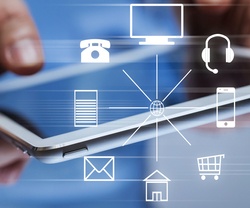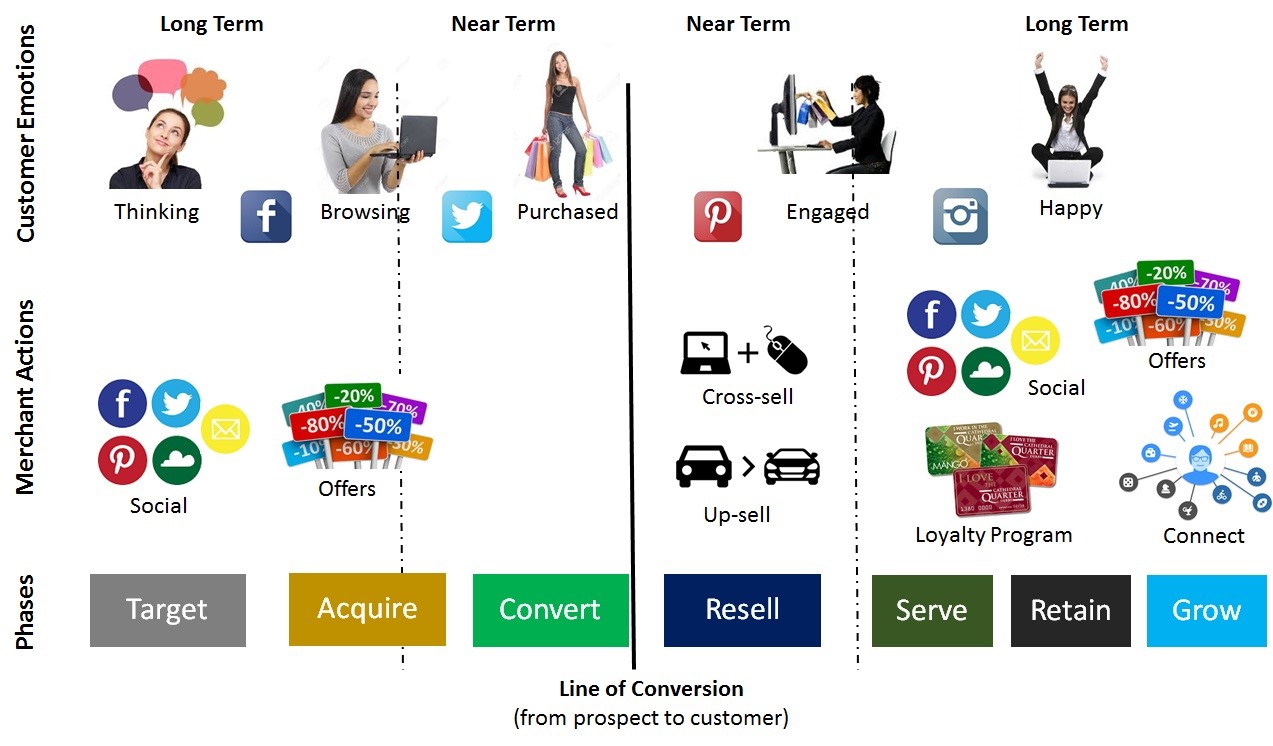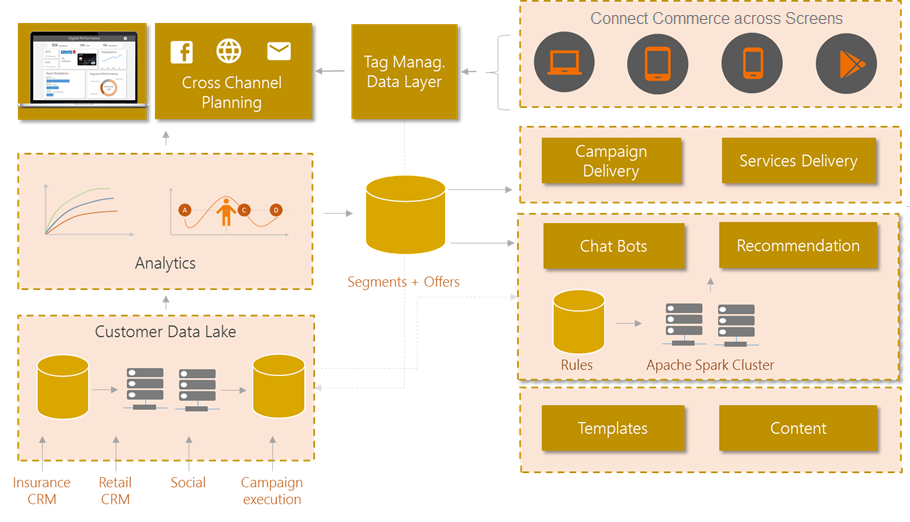 Omni-channel commerce is the latest trend in the B2C commerce space – for both online and offline retail. Today’s customers constantly move across multiple channels and they switch screens all the time (TV, desktop, tablet, mobile), and they also switch platforms (different web sites for product discovery). The key is to capture the attention of customers in an effective way and then guide them to the store (online or offline), convert them to buyers and retain them for a long time. This is the primary challenge all retailers are facing. To effectively use the omni-channel presence of the customers and their 24x7 activities, retailers need to be connected.
Omni-channel commerce is the latest trend in the B2C commerce space – for both online and offline retail. Today’s customers constantly move across multiple channels and they switch screens all the time (TV, desktop, tablet, mobile), and they also switch platforms (different web sites for product discovery). The key is to capture the attention of customers in an effective way and then guide them to the store (online or offline), convert them to buyers and retain them for a long time. This is the primary challenge all retailers are facing. To effectively use the omni-channel presence of the customers and their 24x7 activities, retailers need to be connected.
For a retailer, being connected means:
- Being connected with potential customers across channels without losing context
- Being connected with existing customers while serving them anytime, anywhere
- Facilitating customers to be connected with each other
- All the applications in their enterprise must be connected – only a connected enterprise can create a truly connected customer experience.
The customer journey starts with a potential customer thinking about a product or service, then looking for it and then buying it. The most important line a retailer needs to be concerned about is the ‘line of conversion’ – where a prospect actually converts into a customer. But, the journey does not end there and in fact, this should start a new customer relationship for the retailer. The focus needs to shift in order to engage the customer, retain the customer, nurture the relationship, provide personalized services anywhere & anytime and finally to grow the customer’s life-time value (CLTV). During the entire journey, the customers today stay on social platforms throughout. Each phase of the customer journey (Fig 1) is critical to ensure the retailer also stays connected to the customer.
 Fig 1: Connected commerce lifecycle
Fig 1: Connected commerce lifecycle
On one hand, the customers today are asking for rich and deep mobile experience, 24x7 brand presence, on the other they are tired of an overload of advertisements and have very little patience. If the advertisements are not well targeted and well segmented, it’s safe to say that it will miss the target customer. The key to create (and retain) happy customers is to upgrade the e-commerce to a connected commerce platform. Mobile will lead the connected commerce experience for customers and retailers need to have a deep mobile presence to support that. To understand connected commerce – we need to follow the connected behavior of today’s customers.
Mobile is life – life is mobile
Customers are now using their mobile as their personal shopping assistant and it’s not just limited to their online shopping. Mobile plays a key role in their offline shopping as well.
- 87% of people have their phones with them 24x7.
- 82% of smartphone users say they consult their phones while purchasing something at a store.
- When people use a mobile to search for products, 57% are more likely to visit a store and 51% more likely to make a purchase.
- 61% of smartphone users say they are more likely to buy from mobile sites that personalize their experience (content, location).
The demand from the mobile equipped connected customers is very clear
- They will NOT wait (neither in a queue at a store nor for an online experience that takes more than 3 seconds) for service.
- They want to see detailed information of products around them to make a well-informed decision.
- They want to see personalized and relevant content and not generic ones when it comes to recommendations and new product launches. They also want the retailer to be location-aware.
- They want to see innovative, new products and services all the time.
To cater to demanding customers, implementing new technologies like Chat-Bot, AI/ML driven personalized recommendation engines are a must have for all retailers.
Micro-moments are the new Kodak-moments
In today’s business, a retailer cannot be successful without paying attention to customer's micro-moments. In Fig 1 above, there are many micro-moments (probably a few hundreds) within the customer’s journey and emotions. When these micro-moments are added together it determines the outcomes. Customers expect the retailer to be
- Present with them 24x7 and every step of the way (the phases in Fig 1).
- Fast in responding to their needs, no customer has patience to wait for the retailer to “get back”.
- Relevant while interacting with them and be context aware across devices and screens.
- Assist them in all their journeys, from helping with discovery to buying and then post-purchase support.
Capturing the micro-moments, analyzing them, predicting them and then planning for them is the key. AI/ML plays a central role in the micro-moment strategy of a retailer.
Online to offline – it’s a two-way street
Customers are increasingly switching between online and offline journeys. Customers no longer just go to the nearest store, they go to the nearest screen (TV/desktop/mobile/tablet) and expect the retailer to be there. Similarly, when customers experience a brand, they want the same experience both in-store and on-screen. The trends are –
- Showrooming: Customers browse in a store and while in the store they go online via mobile and look for a better deal and buy.
- Reverse Showrooming or Webrooming: Customers research online and then go to a store to look-touch-feel the product and buy in-store.
- Click-and-pick: Customers order online and then go to the store to pick up the products.
To create a consistent experience, it’s more important now to make sure the customers stay connected during their online as well as offline journeys.
Shopping is a social activity
Customers are more social now than ever. They are active on social media discussing their shopping experiences.
- 74% shoppers rely on Social Media to get more information or read reviews about the products they want to buy.
- 65% of customers rely on social media to find a gift for a loved one.
- 71% shoppers improve the perception of the brands when they see a positive response to a review on social networks.
- 40% of social media users have made a purchase after a product was shared online.
A retailer has to be well connected to social media and connected to their customers (existing and potential) on the social platforms.
Lastly, eCommerce is still largely local but increasingly becoming global and retailers who can present a global catalog to a customer’s screen are more likely to attract more business. More than half of the online users purchase from an overseas retailer. 75% Indian customers who purchased online bought items from an overseas retailer. Technology is enabling this global purchase and the retailers are slowing down implementing a more globally connected Supply Chain system.
To create a successful connected commerce platform for customers, retailers need to think connected and be connected. All the departments and line-of-business applications of the retailer need to be connected as well. The eCommerce pheromone is passé – the future is connected commerce. To make the transition from a traditional eCommerce to a highly connected commerce, the platform design at the highest level should look like the following.
 Fig 2: Reference platform design of connected commerce
Fig 2: Reference platform design of connected commerce
It is clear from customer behaviors that analytics with deep AI/ML integration and a multi-screen presence are a must for building a connected commerce platform. The central piece is a data lake to contain all customer data in raw format so that AI/ML analytics can be easily applied to them which will help with segmentation and cross channel planning. All participating systems will dump their customer-centric data onto this data lake. The campaign design and delivery need to work very closely with the service delivery to create the connected experience across screens. Implementation of Chat-bots and real-time recommendation engines will be key elements as well. This of course will consume the services from the (well-connected) traditional CRM, Supply-chain, fulfillment, payment systems.
Most retailers have content but, the trick is to serve this content to the customers with the right context and at the right moment so that customer micro-moments are not lost. Once a business migrates to a connected business, they will convert their connected customers to happy customers.





